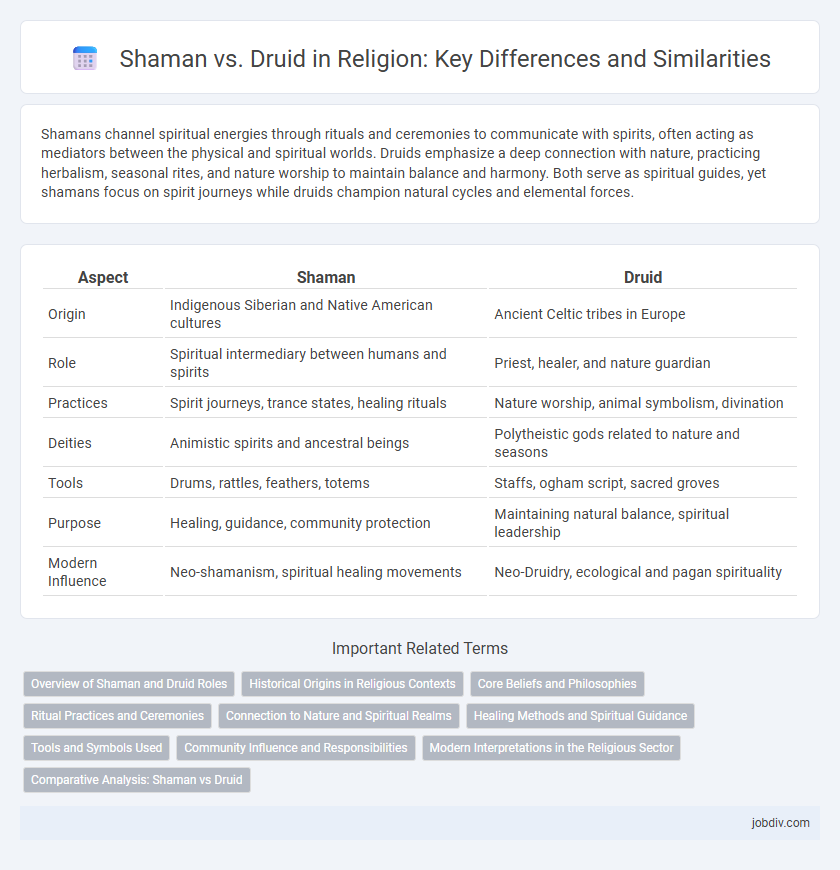Shamans channel spiritual energies through rituals and ceremonies to communicate with spirits, often acting as mediators between the physical and spiritual worlds. Druids emphasize a deep connection with nature, practicing herbalism, seasonal rites, and nature worship to maintain balance and harmony. Both serve as spiritual guides, yet shamans focus on spirit journeys while druids champion natural cycles and elemental forces.
Table of Comparison
| Aspect | Shaman | Druid |
|---|---|---|
| Origin | Indigenous Siberian and Native American cultures | Ancient Celtic tribes in Europe |
| Role | Spiritual intermediary between humans and spirits | Priest, healer, and nature guardian |
| Practices | Spirit journeys, trance states, healing rituals | Nature worship, animal symbolism, divination |
| Deities | Animistic spirits and ancestral beings | Polytheistic gods related to nature and seasons |
| Tools | Drums, rattles, feathers, totems | Staffs, ogham script, sacred groves |
| Purpose | Healing, guidance, community protection | Maintaining natural balance, spiritual leadership |
| Modern Influence | Neo-shamanism, spiritual healing movements | Neo-Druidry, ecological and pagan spirituality |
Overview of Shaman and Druid Roles
Shamans serve as spiritual mediators connecting the physical world with the spirit realm, performing healing, divination, and guidance through trance and ritual. Druids function as priests, scholars, and legal authorities within Celtic societies, overseeing religious ceremonies, preserving knowledge, and maintaining harmony between humans and nature. Both roles emphasize deep spiritual insight but differ in cultural context and ritual practice.
Historical Origins in Religious Contexts
Shamans originate primarily from Siberian and Central Asian indigenous cultures, where they served as spiritual mediators between humans and the spirit world, utilizing trance and ritualistic ceremonies. Druids, linked to ancient Celtic societies in Europe, functioned as religious leaders, legal authorities, and lorekeepers, deeply connected to nature worship and oral tradition. Both roles embody early religious practices but differ significantly in geographic origin, cultural context, and specific spiritual functions within their respective traditions.
Core Beliefs and Philosophies
Shamans believe in a spiritual connection with nature and spirits, acting as intermediaries who perform rituals to heal and guide their communities. Druids embrace a philosophy centered on harmony with the natural world, emphasizing wisdom, knowledge, and the sacredness of trees and ancient traditions. Both traditions view spiritual energy as vital but differ in their approach: Shamans engage in trance and spirit journeys, while Druids prioritize learning, ceremonies, and mediation with the divine.
Ritual Practices and Ceremonies
Shamanic rituals often involve trance states and spirit journeys to communicate with the spiritual realm, using tools like drums, rattles, and ceremonial costumes to facilitate healing and guidance. Druids conduct ceremonies rooted in nature worship, emphasizing seasonal festivals like Samhain and Beltane, incorporating chants, offerings, and symbolic rites to honor deities and natural cycles. Both traditions prioritize the connection between the human and spiritual worlds but diverge in ritual structure and cultural symbolism.
Connection to Nature and Spiritual Realms
Shamans engage deeply with nature through ritualistic practices that invoke animal spirits and elemental forces to facilitate healing and guidance. Druids emphasize a harmonious relationship with the natural world, drawing wisdom from ancient trees, sacred groves, and seasonal cycles to connect with the spiritual realms. Both traditions serve as mediators between humans and the unseen, utilizing distinct cosmologies to access spiritual insights and support community well-being.
Healing Methods and Spiritual Guidance
Shamans utilize trance-induced states and spirit communication to perform healing rituals that restore balance and energy flow within the body, often incorporating natural elements like herbs and drumming. Druids emphasize harmonizing with nature through meditation, sacred groves, and herbal medicine to facilitate holistic healing and spiritual growth. Both traditions serve as spiritual guides, but shamans engage more directly with spirit worlds, while druids focus on the wisdom of nature and ancestral knowledge.
Tools and Symbols Used
Shamans commonly use drums, rattles, feathers, and animal bones as tools to facilitate communication with spirits and perform healing rituals. Druids employ symbols like the oak tree, mistletoe, and sacred circles, along with ritual knives (athames) and staffs, to connect with nature and conduct ceremonies. Both traditions emphasize the use of natural elements and symbolic objects to enhance spiritual practices and symbolize their connection to the divine.
Community Influence and Responsibilities
Shamans serve as spiritual mediators within their communities, facilitating communication with spirits to guide healing, rituals, and protection, thus maintaining societal balance. Druids hold responsibilities as tribal leaders, lawgivers, and educators, shaping cultural traditions and managing religious ceremonies that reinforce community cohesion. Both roles anchor their societies by preserving spiritual knowledge and fostering collective identity through ritual and wisdom.
Modern Interpretations in the Religious Sector
Modern interpretations of Shamans emphasize their role as spiritual healers and mediators between the physical and spiritual worlds, often incorporating elements of indigenous wisdom and ecological awareness. Druids in contemporary religious practice are frequently associated with nature worship, seasonal rituals, and a revival of ancient Celtic traditions adapted to modern neopagan contexts. Both roles have evolved to embrace broader spiritual inclusivity, blending historical roots with present-day environmental and metaphysical concerns.
Comparative Analysis: Shaman vs Druid
Shamans, rooted in Siberian and Central Asian cultures, primarily serve as mediators between the physical and spiritual worlds through trance-induced journeys and animal spirit guides, emphasizing healing and divination. Druids, emerging from ancient Celtic traditions, functioned as priests, philosophers, and legal authorities, focusing on nature worship, ritual sacrifice, and the preservation of oral lore tied to the natural and cosmic order. Both practitioners embody distinct spiritual frameworks: shamans engage in direct spirit communication using drumming and chanting, while druids emphasize ceremonial rites and deep philosophical knowledge linked to renewable cycles and sacred groves.
Shaman vs Druid Infographic

 jobdiv.com
jobdiv.com